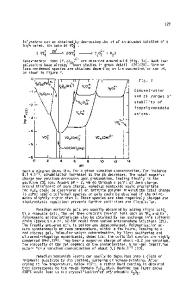How to tailor the porous structure of alumina and aluminosilicate gels and glasses
- PDF / 347,910 Bytes
- 11 Pages / 612 x 792 pts (letter) Page_size
- 25 Downloads / 352 Views
MATERIALS RESEARCH
Welcome
Comments
Help
How to tailor the porous structure of alumina and aluminosilicate gels and glasses V. Vendangea) ONERA-OM BP 72, 92322, Chˆatillon, France
Ph. Colombanb) ONERA-OM BP 72, 92322 Chˆatillon, France and LASNIR CNRS, 2 rue Henry Dunant, 94320 Thiais, France (Received 28 April 1995; accepted 25 September 1995)
Optically clear monolithic (OCM) gels of mesoporous aluminosilicates (average pore diameter 3.6 nm) and alumina (6 nm) have been prepared by slow hydrolysispolycondensation of alkoxides and converted into OCM mesoporous glasses by heating. In order to change the properties, different ways of modifying the pore size and structure are proposed. We show that addition of boron oxide reduces the average pore diameter. A higher effect can be obtained by addition of a surfactant. In this case the mesoporous matrix becomes microporous (d , 2 nm). Another way of modifying the pore structure consists of introducing nanoprecipitates inside the porosity by an impregnation process. Modifications of the porous structure are different in alumina and aluminosilicates.
I. INTRODUCTION
Porous ceramics are finding increasing applications as membranes (separation, purification, etc.), catalysts, and optics. For these applications, synthesis of porous matrices with controlled surface chemistry and tailored pore size is essential. For instance, very small pores called micropores (pore diameter, d , 2 nm) are required in the gas separation process by an inorganic membrane. On the other hand, larger pores, mesopores (2 nm < d < 50 nm) or macropores (d . 50 nm), are necessary for some catalytic reactions or for impregnation with larger molecular weight organic species (organic scintillators, wavelength shifters, or laser dyes).1 The sol-gel process is one of the most practical synthetic routes for porous matrix preparation because of the advantage of being able to make a thermally and chemically stable solid, with a nanoscale pore diameter and narrow pore size distribution. Alkoxide hydrolysispolycondensation creates M–O –M network (with M Al, Si . . . ) with connection defects which induce micropores. Micropores and mesopores are formed by elementary particle aggregation (discussed later). Various methods can be used to adjust the pore size of sol-gel materials and in particular the control of the hydrolysispolycondensation and aggregation parameters. Principal studies discuss the effect of key parameters in the solgel process on porous structure. Lombardi and Klein2 investigated the formulation of the initial solution in a)
Present address: Fraunhofer-institut f¨ur Silicatforschung, Neunerplatz 2, 97082 W¨urzburg, Germany. b) Corresponding author: Tel: 33 (1) 49 78 11 05. Fax: 33 (1) 49 78 13 23. 518
http://journals.cambridge.org
J. Mater. Res., Vol. 11, No. 2, Feb 1996
Downloaded: 14 Mar 2015
the aluminum (sec) butoxide-water-isopropanol system and its effect on the structure of dried gels. Surface area and pore size of alumina and silica with variations in catalyst type and cataly
Data Loading...











